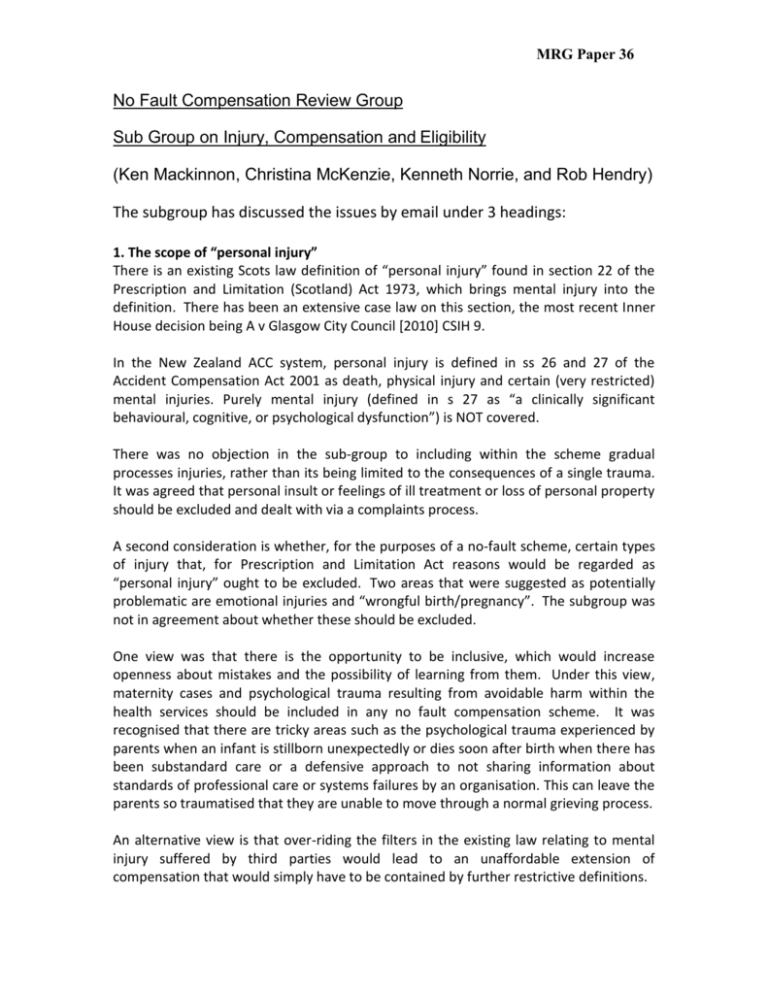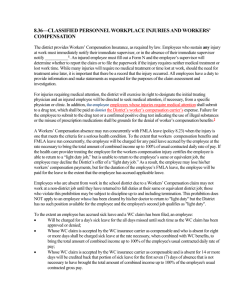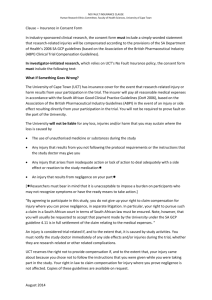No Fault Compensation Review Group
advertisement

MRG Paper 36 No Fault Compensation Review Group Sub Group on Injury, Compensation and Eligibility (Ken Mackinnon, Christina McKenzie, Kenneth Norrie, and Rob Hendry) The subgroup has discussed the issues by email under 3 headings: 1. The scope of “personal injury” There is an existing Scots law definition of “personal injury” found in section 22 of the Prescription and Limitation (Scotland) Act 1973, which brings mental injury into the definition. There has been an extensive case law on this section, the most recent Inner House decision being A v Glasgow City Council [2010] CSIH 9. In the New Zealand ACC system, personal injury is defined in ss 26 and 27 of the Accident Compensation Act 2001 as death, physical injury and certain (very restricted) mental injuries. Purely mental injury (defined in s 27 as “a clinically significant behavioural, cognitive, or psychological dysfunction”) is NOT covered. There was no objection in the sub-group to including within the scheme gradual processes injuries, rather than its being limited to the consequences of a single trauma. It was agreed that personal insult or feelings of ill treatment or loss of personal property should be excluded and dealt with via a complaints process. A second consideration is whether, for the purposes of a no-fault scheme, certain types of injury that, for Prescription and Limitation Act reasons would be regarded as “personal injury” ought to be excluded. Two areas that were suggested as potentially problematic are emotional injuries and “wrongful birth/pregnancy”. The subgroup was not in agreement about whether these should be excluded. One view was that there is the opportunity to be inclusive, which would increase openness about mistakes and the possibility of learning from them. Under this view, maternity cases and psychological trauma resulting from avoidable harm within the health services should be included in any no fault compensation scheme. It was recognised that there are tricky areas such as the psychological trauma experienced by parents when an infant is stillborn unexpectedly or dies soon after birth when there has been substandard care or a defensive approach to not sharing information about standards of professional care or systems failures by an organisation. This can leave the parents so traumatised that they are unable to move through a normal grieving process. An alternative view is that over-riding the filters in the existing law relating to mental injury suffered by third parties would lead to an unaffordable extension of compensation that would simply have to be contained by further restrictive definitions. MRG Paper 36 It was noted that in New Zealand, covered injuries have to occur to the covered person and not to, say, a relative. Questions for the full Group: Should the scope of covered personal injury include: 1. death 2. physical injury 3. mental injury to the patient (including pain syndromes) 4. mental injury to close relatives 5. drug addiction / dependency 6. unwanted pregnancy 7. gradual processes 8. a medical intervention that turns out to have been unnecessary 9. deterioration of an existing condition 10. infection picked up during treatment With the possible exception of 10, it is assumed that the injury is caused by or a result of treatment or failure to properly treat. Note, additionally: 11. the complication of injuries caused in part by existing conditions (see below) 12. the issue of whether to cover a non-treatment injury that is caused by an accident in a place where treatment is given (eg, a patient slips on the hospital linoleum) It was noted too that under the existing “born alive” principle a fetus would have cover for injuries suffered antenatally if it survived. A further aspect of the scope of cover is whether a no fault scheme should extend beyond the public health system to include all health providers. 2. What triggers an award of compensation? It was suggested that there may not be a significant difference in practice between a causation test in the NZ form and the idea of avoidability found in Scandanavian schemes and set out in Peter Walsh’s earlier paper. The NZ criteria were identified: The key in NZ is causation: the injury needs to be caused by treatment, choice of treatment, failure to treat, delay in treatment, mis-diagnosis / non-diagnosis, failure of equipment or of systems, but NOT lack of resources. An injury is not compensable if it is “a necessary part or ordinary consequence of the treatment”. That is determined by looking at all circumstances including the patient’s underlying health and the clinical knowledge at the time of treatment. MRG Paper 36 Separately, an injury is not compensable if it is “wholly or substantially caused by the patient’s underlying health condition”. The fact that a procedure did not achieve the desired result is not of itself sufficient for the granting of cover Legal rules that have taken “causation’ away from a pure “but for” test mean that causation (whether in delict/ tort or in ACC) is a disputed concept. On the other hand, avoidability is not straightforward: avoidable by whose standards? in what conditions? There is a further problem in so far as it may lead back to fault finding: you should have done this better; it's your fault it went wrong. And there is a particular problem concerning the role of hindsight. Issues include: 1. Whether injuries caused by systemic failure or rationing should receive cover. 2. Whether there should be a threshold of seriousness of injury; 3. What time limit there should be for claims. It was noted that while a standard limit of perhaps 1 or 3 years may apply, there could be exceptions where the nature of injuries do not become apparent until many years after the index event, esp in antenatal injuries (see Congenital Disabilities (Civil Liability) Act 1976 in England, Wales and Northern Ireland, and the Scottish Law Commission's report , Liability for Antenatal Injury 3. What is compensation? Compensation, broadly interpreted, can include other entitlements: treatment, rehabilitation of various types (incl vocational retraining) as well as monetary payments. Compensation may also include enabling access to faster rehabilitation treatment or psychotherapy via the private sector if the NHS is unable to provide this in a timely manner. (This is effectively the NZ approach where ACC purchases treatment/ rehab etc from private providers. There is a reduction in transactional costs if ACC pays directly, rather than the patient receiving monetary comp and then having to buy private care.) In NZ, the overall heading is entitlements. These break down into treatment and physical rehabilitation; vocational rehabilitation; social rehabilitation; weekly compensation; lump sums and grants. ACC buys in the required services directly from public and private providers. Lump sums are calibrated according to the degree of incapacity after the injury has “settled” and is seen to be permanent (generally after two years) – using a tariff. The sums are not huge. Weekly compensation (at 80% of earnings) is designed to compensate for financial loss only and continues (in theory) for as long as the injured party (IP) is unable to work. For weekly compensation, there has to be (a) incapacity and (b) lost earnings. The missing 20% is seen as an incentive to the IP to try to return to work. Compensation in its various guises thus tries to meet actual MRG Paper 36 individualised needs. This avoids the speculative calculations of the torts systems – lump sum or tariff. The subgroup supported some sort of threshold (insurance “excess”) to exclude trivial injuries. For a lump sum in NZ, there has to be a 10% whole person impairment before any sum is granted. In Sweden there is a threshold that is a % of the compensation. An alternative threshold would be one that related to the degree of physical incapacity. There seem to be 3 options for monetary payment: (a) a torts/delict type of lump sum that tries to calculate future consequential losses; (b) a tariff which is purely a backward looking compensation at a fixed rate for a particular category of injury; (c) the periodic payment (like social security but linked/ tailored to the patient's individual lost earnings). This lasts for as long - or as short - a period as is needed while/ if the patient recuperates enough to return to the workforce (which may indeed be never). This is not well suited to compensating patients who were not earners at time of injury. There may be issues in relation to integration (or overlap) with the social security system (a UK govt matter). But the fact that social security administers one system of periodic payments does not preclude a second system administered by a different body. There could be combinations of these. There may be merit in paying a lump sum for short-term injuries, and then if there is continuing incapacity, such as in the cases of injured infants or adults who may as a result require life long care, moving to weekly/ intermittent payments. For long term rehabilitation and compensation, the payment would cease or be reduced if the recipient became able to move on to employment at a similar reward level to the one they had been gaining at the time of the injury. In the Swedish model, awards have to be in line with what might be gained via the civil law routes as an incentive for the public to use the least costly route rather than the courts route. In calculating whether a compensation system payment is equivalent in monetary terms to a tort/delict award of damages, some account should be taken of the fact that the lottery is reduced by having a guaranteed payment: "a bird in the hand ...."





